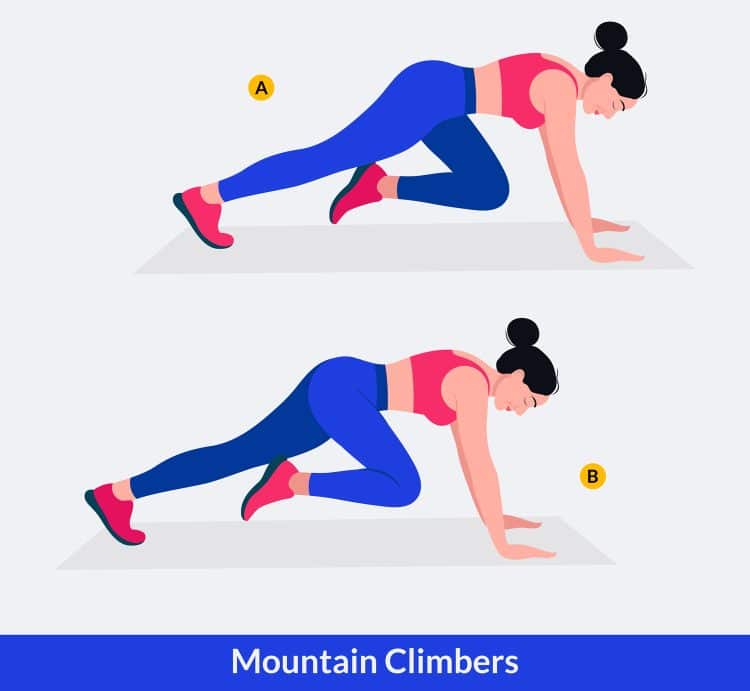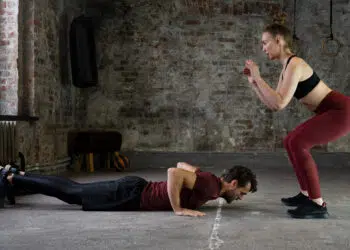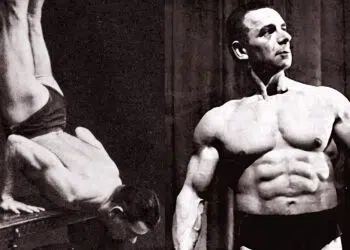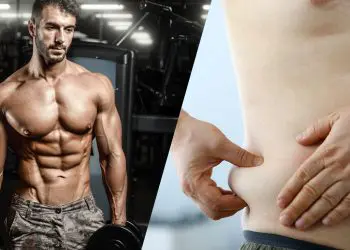Mountain climbers are a fun and challenging way to mix up your workouts, burn calories, improve cardio fitness, strengthen your core muscles, and train your total body. This low-impact, functional bodyweight activity requires decent full-body strength to maintain a high plank/push-up position and there are many great variations for all experience levels.
In this guide, we’ve included exercise instructions, benefits, muscles worked, variations, and more.
How To Do Mountain Climbers
- Start in a high plank/full bodyweight push-up position on your hands and toes with the arms about shoulder width. Keep your body in a straight line from the head to the heels. Your shoulders should be directly over your wrists.
- Tense your core muscles, then bend either knee and bring it in toward your chest. Extend it back out to the starting position.
- Repeat with the other leg and alternate for an equal number of reps per side.
- Start off at a slow pace and then only increase the tempo if you can maintain the same form from setup.
Watch the video example below for a live demonstration…
Mountain Climbers Tips
- Make sure to keep your body weight evenly distributed from top to bottom.
- Avoid lifting your hips up in the air as this removes tension from the core muscles. However, if you struggle to keep the body aligned, it’s perfectly acceptable to bend the hips a little.
- Start off at a slow pace and keep the abdominal muscles engaged throughout the movement.
- Try variations!
Mountain Climber Benefits and Muscles Worked
Let’s talk about the benefits of mountain climbers and the muscles involved during this challenging bodyweight activity.
Strengthen your core
It takes a decent amount of core strength to remain in a high plank position while performing mountain climbers. However, there will come a point when it becomes too easy and that’s why you should also include the more challenging variations.
Improve hip mobility
Limited hip mobility reduces range of motion in the lower body which prevents many people from being able to carry out day to day activities, let alone get in their daily exercise. Including movements that engage and strengthen the hip flexors can help to restore a lot of the motion back in the muscles.
Maintain and improve functional fitness
Mountain climbers have functional carryover to everyday tasks and athletic endeavors. Being a closed chain exercise, they have the potential to recruit more muscle fibers, promote joint stability, and improve neuromuscular coordination.
Level Up Your Fitness: Join our 💪 strong community in Fitness Volt Newsletter. Get daily inspiration, expert-backed workouts, nutrition tips, the latest in strength sports, and the support you need to reach your goals. Subscribe for free!
Burn calories
If you’re goal is to lose weight, mountain climbers can help you to burn more calories and are safer on the joints compared to jogging or running. Increase the speed, intensity, and include the more advanced variations of mountain climbers for enhanced fat loss effects.
Low-impact activity
Unlike running and jumping, mountain climbers are very low-impact and easy on the joints. Consequently, they’re a better option for overweight individuals.
Muscles Worked
Several muscles help to support, stabilize, and facilitate the movement. Below we’ve included brief descriptions of the primary muscles worked.
Core muscles
Effective mountain climbers requires a strong and rigid midsection to prevent energy leaks that will slow down your productivity and efficiency during this activity. The abdominals, obliques and spinal erectors all play a part in keeping the body in position and maximizing movement.
Hip flexors/psoas
The psoas muscles help to bend the hips and bring the knees forward during mountain climbers. Therefore, you’ll need to have strong hips or you won’t be very efficient.
Glutes
Butt muscles aren’t just for show (even though a well developed gluteus maximus will make you look amazing in tight pants). When they have the reason to, the butt is a strong thigh extensor and will perform to extend the legs. Squeezing the glutes helps to maintain a strong body during mountain climbers.
Quadriceps
The four headed quadriceps muscles generate a lot of force during hip flexion and knee extension. Therefore, a lot of your performance will come from the quads muscles.
Hamstrings
The muscles in your posterior thigh are called the hamstrings that contribute a lot to the aesthetics and performance of the lower body. Unlike the opposite quads muscles, hamstrings extend the hips and flex the knee joint.
Pectorals
Strong pecs are highly desired but they’re more than a beach muscle. Your pectoral muscles Assist in flexion, horizontal and vertical adduction, extension, and internal rotation of the upper extremity. Mountain climbers do engage the pectoral muscles to a degree however, they are not a good option for building size and strength.
Deltoids
The deltoids are your shoulder muscles that have an anterior, lateral and posterior head, all functionally different. For example the anterior (front) head flexes the arms forward while the lateral head raises the arms up and out to the sides and the posterior head pulls the upper torso back.
Triceps
The triceps are a three-headed muscle on the back of the upper arms. They primarily function to extend the elbow, and help support the body’s weight during mountain climbers.
11 Mountain Climber Variations
Mountain climbers can give you one heck of a workout, but we also like these variations from beginner to more advanced.
Level Up Your Fitness: Join our 💪 strong community in Fitness Volt Newsletter. Get daily inspiration, expert-backed workouts, nutrition tips, the latest in strength sports, and the support you need to reach your goals. Subscribe for free!
Plank
Performing mountain climbers while on your forearms in a plank position is more challenging as it reduces the space between your body and the ground.
Cross-body
Engage your obliques by bringing the left knee toward the right shoulder, and the right knee to the left shoulder.
Jumping
Jump both legs forward and backward at the same time.
Reverse mountain climbers
Turn your body around facing away from the floor in a reverse high plank and alternate lifting your knees to your chest.
Hands elevated
Elevate your hands onto a bench or any object that sits higher than floor level. This should make the exercise a little easier.
Feet elevated
Elevate your feet onto a bench or any object that sits higher than floor level. This makes the movement a little more challenging.
One-Arm
One-arm mountain climbers require more upper body and core strength to keep the body stable.
Band-resisted
Attach a resistance band to an immovable object and wrap it over your shoe. Resistance mountain climbers will challenge your leg and core muscles even more.
TRX
The TRX suspension trainer or its alternatives are a great workout tool for developing core strength and total-body stabilization.
Stability ball
Try mountain climbers with the hands elevated on a stability to place more demand on your core muscles.
Dead hang
The dead hang variation positions your body upright, closer replicating climbing up a mountain. Additionally, hanging from a pull-up bar and the weight of your legs provides a greater challenge to the core and hip flexors.
Incorporate Mountain Climbers In Your Workouts
Here are a three effective ways to include mountain climbers in your workouts.
Circuits
Circuit training is one of the best ways to include all of your favorite exercises in one cardio-based workout session. The idea is to perform a gauntlet of movements back to back with little to no rest in between for multiple rounds.
HIIT (high intensity interval training)
Mountain climbers are a great fit for high intensity interval training workout sessions. Set a timer for 30 seconds and move your feet as fast as possible. Rest 20 seconds and repeat two to three more times.
Finisher
Close out any training session with an all-out set of mountain climbers at your own pace. This will get the heart rate up, burns calories and condition your muscles.
Try these 20 simple fat loss finishers.
Bottom Line
Mountain climbers offer a functional bodyweight-only cardio activity that can be done from almost anywhere. They also come with many different variations so there are plenty of options to mix up your training and challenge yourself based on your level of strength and capabilities.
Interested in measuring your progress? Check out our strength standards for Mountain Climbers.












